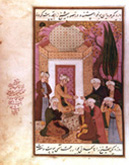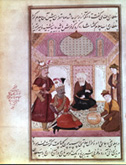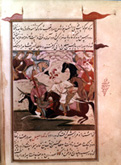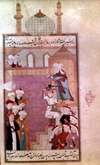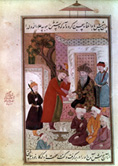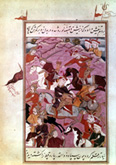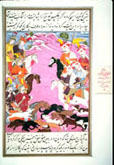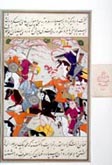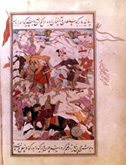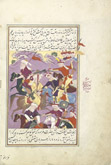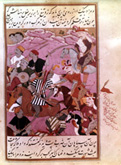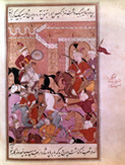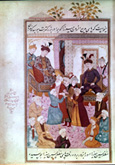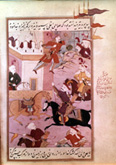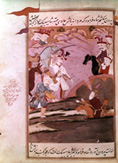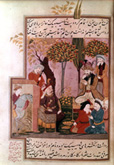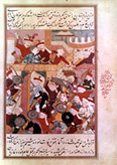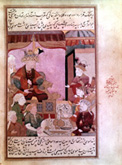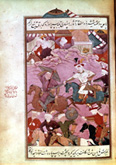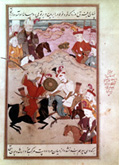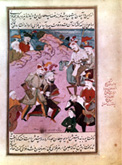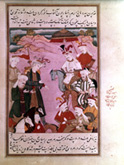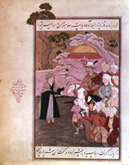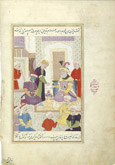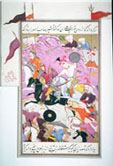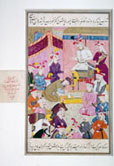RAM folio 11
RAM folio 13
RAM folio 17
RAM folio 42v
RAM folio 48v
RAM folio 51
RAM folio 87 (?)
RAM folio 94v (?)
RAM folio 114v
RAM folio 135v
RAM folio 165
RAM folio 186v
RAM folio 199v
RAM folio 210
RAM folio 217
RAM folio 241v
RAM folio 273v
RAM folio 280
RAM folio 298v
RAM folio 332v
RAM folio 339v
Moʿin Moṣavver | manuscript M |
History of Shah Esmāʿil (tāriḵ-e ʿālām-ārā-ye šāh esmāʿil)
A semi-dispersed copy of what is probably an ʿālām-ārā-ye šāh esmāʿil, illustrating events during the reign of Shah Esmāʿil, with a preamble on his progenitors.
Location:
353 bound folios containing 21 paintings are presently in the Reza Abbasi Museum, Tehran, having apparently been transferred there after the revolution from the Negarestan Museum where it was previously housed as collection no. 77.1.7. Prior to that it was in the Mahboubian Collection in New York.
Seven detached
leaves most probably from the same manuscript are currently known: one is in the Harvard Art Museum, four are in a private collection, and two others whose current whereabouts are unknown.
Text and page sizes are not availble for all of the pages, but those that are corroborate that all pages are of comparable measurements. Although the existing evidence is not totally conclusive, each new piece of evidence suggests more and more that all were part of one manuscript. The "re-assembled" manuscript to date includes 28 paintings, including one (f.332v) inscribed in Moʿin’s handwriting, but that part of the inscription that might have included his signature has been smudged, and is now illegible. A later attribution next to it claims the painting to be the work of Moʿin Moṣavver. The 27 other paintings, although unsigned, are equally in the style of Moʿin, and can be attributed to him, albeit perhaps with workshop assistance.
For a detailed discussion of the evidence supporting the attribution of the loose pages to the bound Tehran volume see ms.M - Problematic aspects
In order to most closely re-create the sequence of the paintings that were in the manuscript originally, both the loose folios and the bound segment have been organized here in sequential date order of the event in accordance with the ʿālām-ārā-ye šāh esmāʿil. This is the SE number, and refers to the page number in Muntaẓer-Ṣāḥeb_1970. The paintings from the bound portion in Reza Abbasi Museum also have the folio number.
Folio size: 35.6 x 21.6 cm. (from Mahboubian Catalog)
Written surface: 21.3 (scaled) x 13.1 cm;
Text is written in good nastāʿliq, without columns, 15 lines to the page.
Dating:
The text of the ʿālām-ārā-ye šāh esmāʿil contains anachronisms referring to mid 17th century events, indicating that it was compiled, not at the end of Shah Esmāʿil's reign as implied, but rather in 1087/1676-67 (Morton, Pembroke_1990, p.188). The author has not been identified. The inscription on folio 332v contains a date, the middle of RabiʿI in the year 1010/September 1601. Since the date is stylistically impossible, the year intended might rather be interpreted as 1100/January 1689. The reversal of digits in dates involving zeros occurs often in the latter seventeenth century.
Bibliography:
Muntaẓer-Ṣāḥeb_1970.
Mahboubian_1972, no. 923.
Morton, Pembroke_1990, p.188.
Robert Eng
Last Updated: April 19, 2012 | Originally published: Mar. 28, 2002 | Revised: Nov. 30, 2010
